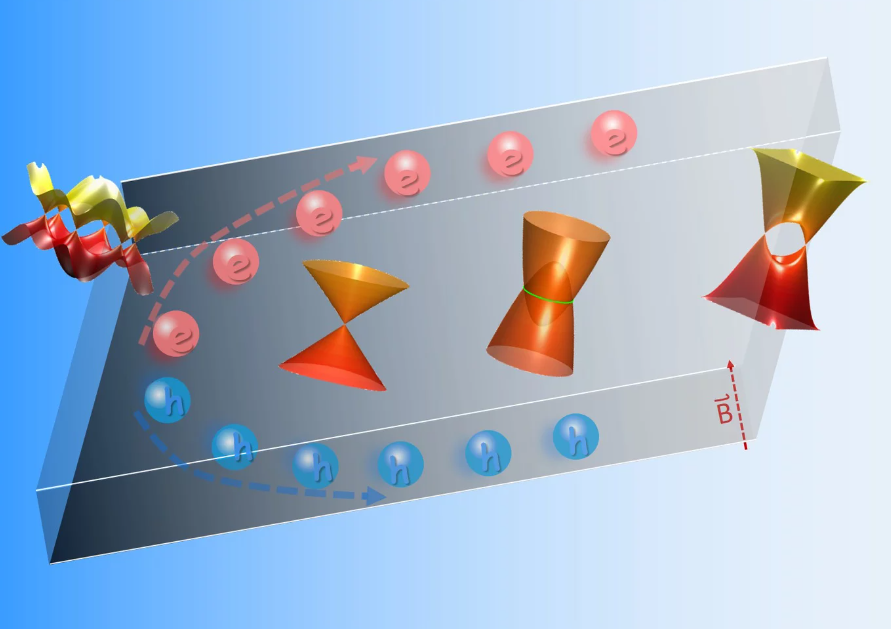Researchers from the University of Minnesota Twin Cities have achieved a remarkable breakthrough by synthesizing a thin film of a unique topological semimetal material. This marks the first time such a material has been created. Showcasing its immense potential for revolutionizing computing power and memory storage while significantly reducing energy consumption.
The innovative thin film opens up new avenues for developing more efficient electronic devices that can handle advanced computing tasks and store vast amounts of data, all while minimizing the environmental impact through energy savings. The University of Minnesota team’s breakthrough represents a significant step forward in harnessing the capabilities of topological semimetals for the next generation of high-performance, energy-efficient technology.
Understanding Topological Semimetals
To comprehend the significance of topological semimetals, it’s essential to understand their unique properties. Traditional semiconductors have energy bandgaps that separate valence and conduction bands, restricting the movement of electrons. In contrast, topological semimetals exhibit peculiar band structures characterized by the presence of gapless electronic states, allowing electrons to move freely through the material. This property opens up new possibilities for manipulating and harnessing electrons for computing and storage applications.
Topological Semimetals: Pioneering Quantum Materials for Next-Generation Electronics
The United States’ recent CHIPS and Science Act highlights the pressing need to boost semiconductor manufacturing and invest in materials research for electronic devices. While traditional semiconductors have been the foundation of modern computer chips, researchers continuously seek new materials capable of delivering higher power output with reduced energy consumption, aiming to enhance the efficiency, size, and performance of electronic devices.
This drive has led scientists and engineers to explore alternative materials that can generate more power while consuming less energy. By pushing the boundaries of materials science, these researchers hope to revolutionize the field, creating electronics that are not only more powerful but also smaller and more energy-efficient.
This is a class of quantum materials, hold immense promise as candidates for advanced computer chips. These materials exhibit electron behavior that differs from traditional insulators and metals, granting them unique properties. As a result, they are being extensively studied for their potential in spintronic devices, which offer an alternative approach to conventional semiconductors by utilizing the spin of electrons for data storage and processing, rather than relying solely on electrical charge. The distinct characteristics of topological semimetals open up new avenues for developing highly efficient and innovative electronic devices.
Harnessing Energy Efficiency
One of the most compelling advantages of topological semimetals is their remarkable energy efficiency. Conventional computing and storage systems rely heavily on energy-intensive processes, leading to increased power consumption and heat dissipation. Topological semimetals, on the other hand, enable the design of energy-efficient devices by exploiting their unique electronic properties.
By leveraging the gapless electronic states in this, researchers can develop low-energy computing architectures that drastically reduce power requirements. These materials have the potential to minimize energy loss during information processing, leading to significant energy savings and reduced environmental impact.
Read More: Optoelectronics Nanotechnology: MIT’s NanoLED Array Growth
Topological Semimetals Enhanced Computing Power
In addition to energy savings hold the key to unlocking enhanced computing power. The gapless nature of their electronic states allows for the creation of ultrafast electronic devices capable of processing information at unprecedented speeds. This potential boost in computational performance can revolutionize various fields, including artificial intelligence, data analytics, and scientific simulations.
Furthermore, the unique electronic properties of topological semimetals facilitate the development of novel computing paradigms such as quantum computing. These materials can serve as a platform for hosting and manipulating quantum bits (qubits) due to their robustness against external disturbances. Harnessing topological semimetals for quantum computing could unleash exponential computational capabilities, enabling solutions to complex problems that are currently beyond the reach of classical computing systems.
1. Advanced Memory Storage
Topological semimetals also hold great promise for transforming memory storage systems. Traditional memory technologies, such as volatile random-access memory (RAM) and non-volatile flash memory. These are facing challenges concerning speed, density, and power consumption. This offer an alternative approach by leveraging their unique electronic properties to create next-generation memory devices.
For instance, researchers have explored the use of this in developing resistive random-access memory (RRAM). The memory technology with high-speed write and read operations, low power consumption, and excellent scalability. The gapless electronic states of topological semimetals enable efficient control of resistive switching, a fundamental mechanism in RRAM. This is leading to improved memory performance and energy efficiency.
2. Topological Semimetals Challenges and Future Directions
While the discovery of topological semimetals marks an exciting development, several challenges lie ahead. The practical implementation of topological semimetals in computing and memory systems requires overcoming fabrication, integration, and scalability hurdles. Additionally, further research is needed to understand the stability and reliability of these materials over extended periods of operation.
Looking forward, interdisciplinary collaboration among materials scientists, physicists, and engineers. We will play a crucial role in harnessing the full potential of topological semimetals. Continued exploration of their properties, coupled with advancements in nanofabrication techniques, will pave the way for practical applications in energy-saving computing and memory storage.
Conclusion
The breakthrough in topological semimetals offers a glimpse into a future. Where we computing and memory systems are not only more powerful but also energy-efficient. By harnessing their unique electronic properties, topological semimetals have the potential to reshape the technological landscape.
Also the enabling faster and more sustainable computing solutions. As researchers continue to unlock the mysteries of these materials and overcome the associated challenges. A promising future awaits us in the realm of computing and storage as we anticipate an era of groundbreaking advancements. That is promises to revolutionize industries and drive innovation for years to come.
